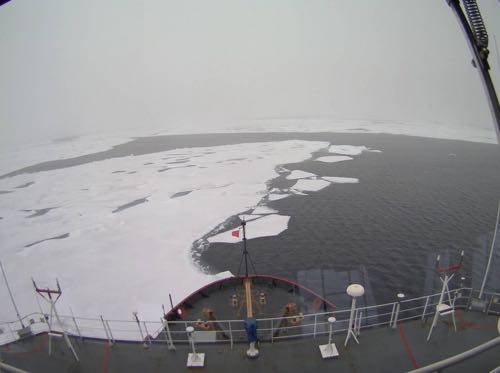Predicting The Unpredictable
This is a broad expedition with many different components. Time aboard the ship is both precious and costly. For these reasons, the work continues 24/7. The whiteboard on which the predicted daily schedule is published is referred to as "The Board of Lies", and is subject to change at any time. Weather, wind, ice pack, equipment adjustments can all be reasons for changes to the schedule. As with many things, deploying equipment on a ship in the Arctic often takes longer than expected. Because we are above the Arctic Circle in July, there is constant daylight, so darkness is not a deterrent.
During the transit to a new station, while other teams are preparing for sleep, the bird and mammal teams are beginning the more intensive part of their work. Although the schedule is unpredictable and constantly changes, there has become a rhythm in the work. When we arrive at a new station, the CTD is usually the first piece of equipment to be deployed. Depending upon depth, this may take an hour to several hours. The CTD may be followed by, depending upon need and practicality, the box corer, trawl nets, multi nets, the ROV, and sometimes ice work. Each team knows what needs to be completed, and everyone works to accomplish whatever needs to be done.
We are able to access camera images of work areas from the ship's intranet. This can be helpful in knowing the status of equipment deployments. In the image shown below, one can see scientists on the fantail (gray hard hats for science) preparing a component of the ROV. The box corer is seen strapped to the deck in the foreground.
 Work on the fantail.
Work on the fantail.
This image shows the bow of the boat and ice ahead.
 Open water and ice ahead as seen in one of the ship's cameras.
Open water and ice ahead as seen in one of the ship's cameras.
Question and Answer
Question of the Day: Do you think you would like to have 24 hours of constant daylight?
Answer From Last Q: Beluga whales hunt and eat many kinds of fish, including Arctic cod, salmon, and herring as well as crustaceans such as shrimp and crabs. Bowhead whales are baleen whales that gulp a mouthful of water and then and filter out tiny organisms such as zooplankton, including copepods and shrimp-like animals known as euphausiids that are only 1-3 mm in length. Scientists estimate that a bowhead whale needs to eat about 100 metric tons of this kind of food each year. (Source: http://www.afsc.noaa.gov/nmml/education/cetaceans/bowhead.php#eat)


Comments